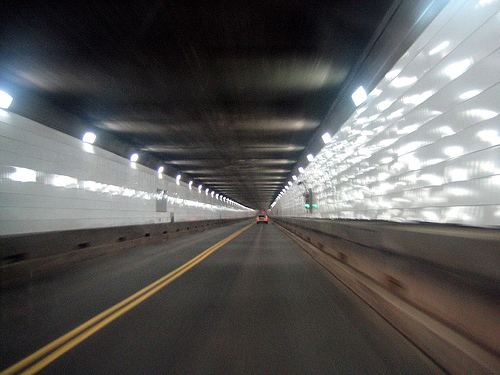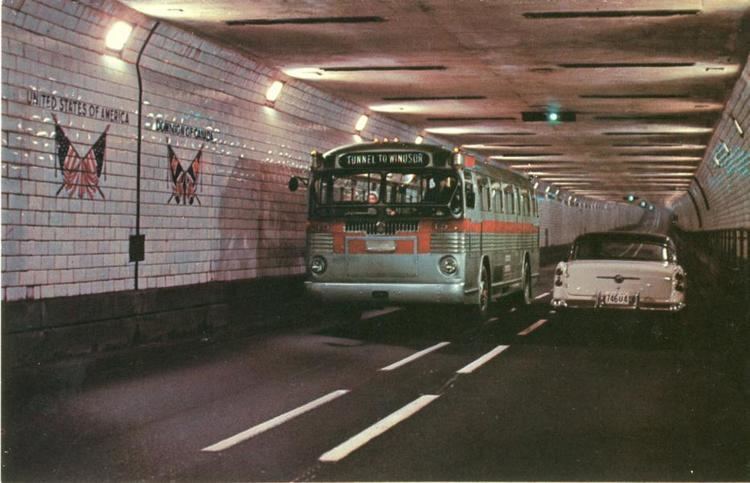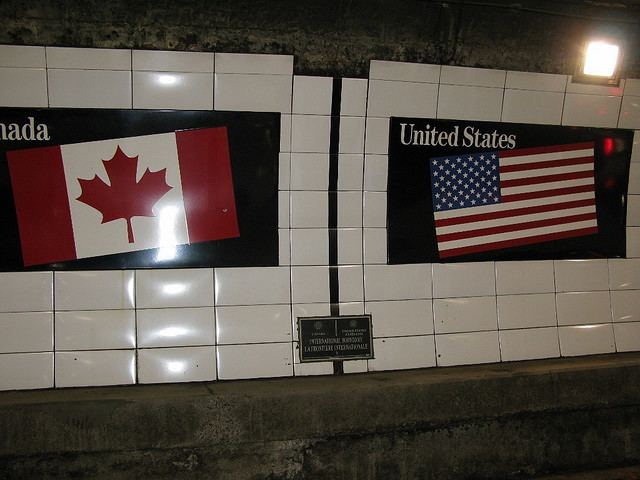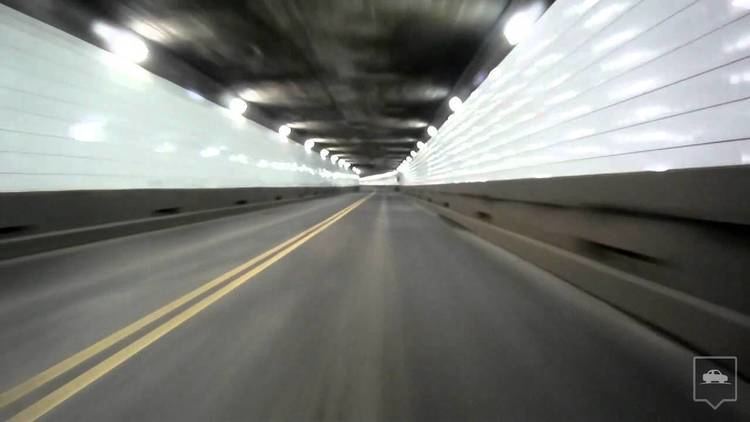Traffic 13,000 vehicles Length 1,570 m Width 6.7 m Locale Detroit, Windsor | No. of lanes 2 Opened 1930 Architect Søren Anton Thoresen | |
 | ||
Location Detroit River between Detroit, Michigan and Windsor, Ontario Route Connecting Jefferson Avenue (near I-375 and M-10) and Goyeau Street Operator Detroit-Windsor Tunnel Company, LLC Toll USD 4.50/CAD 4.50 (autos travelling into US)
USD 4.75/CAD 4.75 (autos travelling into Canada) Owners Detroit City Council, Windsor City Council Similar Ambassador Bridge, Blue Water Bridge, Detroit River, Gordie Howe Internatio, Caesars Windsor | ||
The Detroit–Windsor Tunnel (French: Tunnel Detroit-Windsor) is a highway tunnel connecting Detroit, Michigan, in the United States, with Windsor, Ontario, in Canada. It is the second busiest crossing between the United States and Canada.
Contents
- Construction
- Completion in 1930
- Ownership since 2007
- Usage
- Traffic
- Tolls
- Tunnel truck for disabled vehicles
- CKLW WJR and the tunnel
- Ventilation
- References

Construction

The Detroit–Windsor Tunnel was built by the firm Parsons, Klapp, Brinckerhoff and Douglas (the same firm that built the Holland Tunnel). The executive engineer was Burnside A. Value, the engineer of design was Norwegian-American engineer Søren Anton Thoresen, while fellow Norwegian-American Ole Singstad consulted, and designed the ventilation.

The method used to construct the tunnel was immersed tube (sections of steel tube floated into place and sunk into a trench dug in the river bottom), as was done in the earlier Posey Tube. The tunnel sections have three main levels. The bottom level brings in fresh air under pressure, which is forced into the mid level, where the traffic lanes are located, and the third level is where the engine exhaust is forced into and vented at each end of the tunnel. Total cost of construction was approximately $25 million US dollars (around $358 million in 2016 dollars).

The river section of the tunnel was connected to bored tunnels on both banks. The tubes were then covered over in the trench by 4 to 20 feet (1.2 to 6.1 m) of mud. Because the tunnel essentially sits on the river bottom, there is a wide no-anchor zone enforced on river traffic.

The tunnel is 120 feet (37 m) short of a mile at 5,160 feet (1,573 m). At its lowest point, the two-lane roadway is 75 feet (23 m) below the river surface.
Completion in 1930

The Detroit–Windsor Tunnel was completed in 1930. It was the third underwater vehicular tunnel constructed in the United States, following the Holland Tunnel, between Jersey City, New Jersey, and downtown Manhattan, New York, and the Posey Tube, between Oakland and Alameda, California.
Its creation followed the opening of cross-border rail freight tunnels including the St. Clair Tunnel between Port Huron, Michigan, and Sarnia, Ontario, in 1891 and the Michigan Central Railway Tunnel between Detroit and Windsor in 1910.
The cities of Detroit and Windsor hold the distinction of jointly creating both the second and third underground tunnels between two nations in the world. The Detroit–Windsor Tunnel is the world’s third underground tunnel between two nations, and the first international underground vehicle tunnel. The Michigan Central Railway Tunnel, also under the Detroit River, was the second tunnel between two nations. The St. Clair Tunnel, between Port Huron, Michigan, and Sarnia, Ontario, under the St. Clair River, was the first.
Ownership since 2007
In 2007, billionaire Manuel Moroun, owner of the nearby Ambassador Bridge, attempted to purchase the American side of the tunnel. In 2008, the City of Windsor controversially attempted to purchase the American side for $75 million, but the deal fell through after a scandal involving then-Detroit Mayor Kwame Kilpatrick.
Soon afterward, the city's finances were badly hit in a recession and the tunnel's future was in question. Following Detroit's July 2013 bankruptcy filing, Windsor Mayor Eddie Francis said that his city would consider purchasing Detroit's half of the tunnel if it was offered for sale.
On July 25, 2013, the lessor, manager and operator of the tunnel, Detroit Windsor Tunnel LLC, and its parent company, American Roads, LLC, voluntarily filed for chapter 11 bankruptcy protection in the United States Bankruptcy Court for the Southern District of New York.
The American lease was eventually purchased by Syncora Guarantee, a Bermuda based insurance company. Soon afterward, the lease with Detroit was extended 2040. Both Syncora and Windsor retained the Windsor-Detroit Tunnel Corporation to manage the daily operations and upkeep of the tunnel.
Usage
The tunnel is the second busiest crossing between the United States and Canada after the nearby Ambassador Bridge. A 2004 Border Transportation Partnership study showed that 150,000 jobs in the region and $13 billion (U.S.) in annual production depend on the Windsor-Detroit international border crossing. Between 2001 and 2005, profits from the tunnel peaked, with the cities receiving over $6 million annually. A steep decline in traffic eliminated profits from the tunnel from 2008 until 2012, with a modest recovery in the years since.
Traffic
Historically, the tunnel carried a smaller amount of commercial traffic than other nearby crossings because of physical and cargo restraints, as well as limits on accessing roadways. Passenger automobile traffic on the tunnel increased from 1972, until it peaked in 1999 at just under 10 million vehicle crossings annually. After 1999, automobile crossings on tunnel declined, dropping under 5 million for the first time in over three decades in 2007. Traffic on the tunnel later recovered slightly in the following years when the economy began to improve after 2008.
Tolls
Vehicles pay a fee to pass the tunnel. Motorcycles are prohibited from using the tunnel.
Tunnel truck for disabled vehicles
When the tunnel first opened in 1930s the operators had a unique rescue vehicle to tow out disabled vehicles without having to back in or turn around to perform this role. The vehicle had two drivers, one facing in the opposite direction of the other. The vehicle was driven in, the disabled vehicle was hooked up, then the driver facing the other way drove it out. This emergency vehicle also had 600 feet (180 m) of water hose with power drive and chemical fire extinguishers.
CKLW, WJR and the tunnel
In the late 1960s, Windsor radio station CKLW AM 800 engineered a wiring setup which has allowed the station's signal to be heard clearly by automobiles traveling through the tunnel. Currently Detroit radio station WJR AM 760 can be heard clearly in the tunnel.
Ventilation
The upper and lower levels of the tunnel are used as exhaust and intake air ducts. One hundred foot ventilation towers on both ends of the tower enable air exchange once every 90 seconds.
